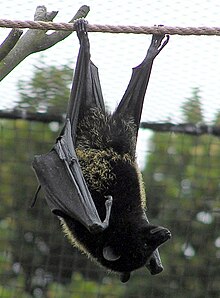Pteropus livingstonii
| Livingstone's fruit bat | |
|---|---|
 |
|
| Scientific classification | |
| Kingdom: | Animalia |
| Phylum: | Chordata |
| Class: | Mammalia |
| Order: | Chiroptera |
| Suborder: | Megachiroptera |
| Family: | Pteropodidae |
| Genus: | Pteropus |
| Species: | P. livingstonii |
| Binomial name | |
|
Pteropus livingstonii Gray, 1866 |
|
 |
|
| Livingstone's fruit bat range | |
Livingstone's fruit bat (Pteropus livingstonii), also called the Comoro flying fox, is a megabat in the genus Pteropus. It is an Old World fruit bat found only in the Anjouan and Mohéli islands in the Union of the Comoros in the western Indian Ocean.
It is the largest and rarest bat of all Comorian species. Its preferred habitat is montane forest above 200 metres on Mohéli and above 500 metres on Anjouan, the destruction of which is a major threat to the bat population. As of 2003, the total population was estimated at 1,200 individuals. Other threats to the bats' survival include storms, hunting, and their struggles to readapt to new habitats.
The black-bearded flying fox is believed to be one of the closest relatives of Livingstone's fruit bats, but experts differ as to whether or not these species belong to the same species group. No subspecies have been recognized.
Livingstone's fruit bats are mostly black in colour, with a scattering of golden or tawny hairs over the rump, belly, and flanks. The amount of golden hair varies between individuals, with some also having a narrow band of golden fur down the back, or golden patches on the shoulders, and others being pure black without any paler hair at all. The wings are black and hairless, as are the legs, nose, and large, rounded ears.
Distinguishing characteristics include their rounded ears, the colour of their fur, and their large, orange or red eyes, reflecting this bat’s well-developed vision. Livingstone's fruit bats weigh 500 to 800 g (18 to 28 oz). They have a body length of about 30 cm (12 in) and a wingspan up to 1.4 m (4 ft 7 in). They do not exhibit sexual dimorphism.
The bats have a relatively slow, flapping flight, and often circle in an attempt to gain height, but are also, unlike nocturnal bats, capable of soaring on air thermals. Their wings have an aspect ratio of 6.52, and a wing loading of 25.8 N/m2, and have been estimated to have a turning circle of 11.3 m (37 ft).
Livingstone's fruit bat is found only on the islands of Anjouan and Mohéli, within the Comoros archipelago between Africa and northern Madagascar. It inhabits montane forest above 200 m on Moheli and above 500 m on Anjouan. All current Livingstone’s fruit bat roosts are restricted to a narrow midaltitudinal range and are strongly associated with the presence of native and endemic trees, with the biggest roosts located in dense-canopy, old-growth forest. Livingstone’s flying fox appears to show a preference for roosting in certain tree species, in particular the endemic Nuxia pseudodentata and native Gambeya spp. and at forested sites that are typically found on steep slopes, next to valleys where permanent watercourses are present, and facing in a southeast direction and in depressions to provide protection from wind and the midday sun. Only 15 roost-sites are currently occupied in Anjouan and six at Moheli.
...
Wikipedia

